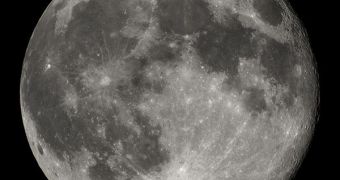Our understanding of the Moon has advanced considerably in the last year. A number of independent missions have discovered that water-ice exists at the lunar poles, and that water molecules are also trapped in regular regolith rocks on its surface. But a new investigation shows that the interior of the Moon is completely and utterly dry, regardless of the significant amounts of water found on its surface. The new study was based on analysis of the lunar rocks' chlorine composition, Space reports.
“Lots of publications about water being found on the Moon talk about ice that resides on the lunar surface. This is not what we're talking about. We're talking about water that was initially in the Moon as it formed,” says professor Zachary Sharp, who is based at the University of New Mexico, in Albuquerque, N.M. He was the lead research of the new investigation, details of which appear in the August 6 issue of the esteemed journal Science. The group he conducted looked closely at the lunar samples brought back from the Moon by Apollo astronauts.
The main target of investigations was the chlorine isotopes known as chlorine-35 and chlorine-37. The prevalence of these particular type of atoms was analyzed in lunar samples, primitive meteorites that struck Earth, and early rocks from our own planet. The ratio of chlorine isotopes varied by only 0.1 percent between Earth rocks and meteorites, but the Moon regolith gave different results. “We quickly found huge variability in the lunar chlorine isotope ratio. It was 25 times that of Earth. We were confounded,” Sharp explains. He says that the study allowed the team to determine the prevalence of other chemicals on the Moon, including hydrogen, a critical element for forming water.
“Knowing the chlorine content, we can back-calculate the amount of hydrogen. We found that the hydrogen content had to be really low, so essentially the moon was extremely dry relative to Earth,” the team leader says. He adds that the team found chlorine salts in the Moon's interior, which is additional proof that there's no water there. “The levels of hydrogen had to be less than the chlorine, otherwise we would have Hcl [hydrogen chloride] rather than these chloride salts. If we had made HCl, we wouldn't have fractionation. Knowing the chlorine content gives us an upper limit on the hydrogen content. So, we know that there had to be less hydrogen than chlorine,” Sharp concludes.

 14 DAY TRIAL //
14 DAY TRIAL //